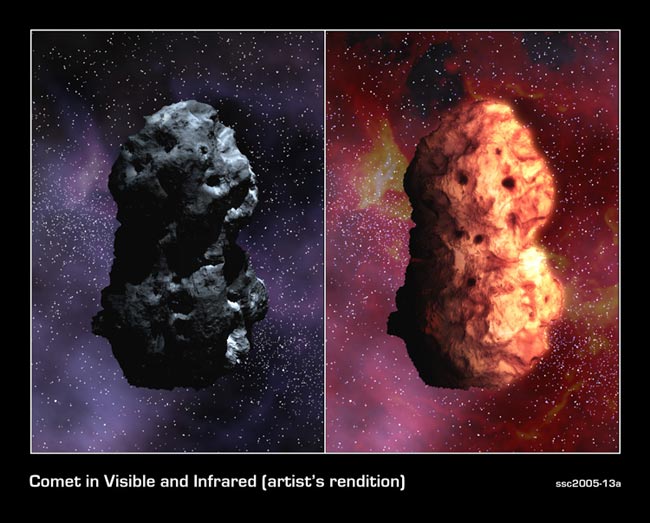Deep Impact Poised to Crack Comet Mysteries

In ancient cultures, comets were believed to be demons or divine messengers and were regarded as omens of impending disaster and tragedy. Compared to stars, whose positions were known, and planets, whose courses were predictable, comets were capricious and their movements erratic. Their existence seemed to contradict the idea--popular in ancient times--that the universe was a neat and orderly place.
Modern science has changed that view dramatically. Instead of being just heralds of misfortune, many scientists now believe comets are actually harbingers of life, responsible for bringing precious water and organic material to Earth.
Ideas about what comets are made of have changed too, even in the past decade. In the 1950s, comets were portrayed as dirty snowballs. Now scientists suspect they're heavier on the dirt and lighter on the water ice.
"Comets are thought to be icy dirtballs made up of exotic ices, dust, and rock particles," explained Donald Yeomans, manager of NASA's Near Earth Objects Program and a co-investigator of the agency's Deep Impact mission. Among the chemicals in a comet: frozen carbon dioxide, frozen ammonia, and solid methane.
Up close look
On July 4, the Deep Impact mission will smash a probe into Tempel-1, a potato-shaped comet discovered in 1867 and believed to be representative of most comets. The impact will carve out a stadium-sized crater and provide valuable information about a comet's interior.
Most comets are believed to come from the Oort cloud, a swarm of small, rocky and icy bodies at the outermost fringes of the solar system -- just barely within grasp of the Sun's gravity. Astronomers believe that the tug of neighboring stars occasionally loosens one of these objects from its icy post and sends it careening either inward, through our solar system, or outward, into interstellar space, where they will drift forever unless lassoed by another star's gravity.
Breaking space news, the latest updates on rocket launches, skywatching events and more!
Comets are believed to be remnants of the dust and debris that once swirled around the infant Sun and which coalesced into planets approximately 4.5 billion years ago. They might therefore be frozen time capsules, containing material from the early solar system.
"If you wish to study what the solar system is made of you study comets," Yeomans told SPACE.com.
Anatomy of a comet
Comets are made up of three main parts: a nucleus, coma, and tail. The comet's nucleus is composed mainly of ice, gas and dust and is generally less than 30 miles across, often just a mile or two. Very little is known about a comet's nucleus because in a normal, healthy comet--one whose supply of ice and gas hasn't yet been exhausted--the nucleus is hidden from view, shrouded by the comet's coma, a dense halo of iridescent dust and gas and streaming ice particles.
A comet actually has two tails: one of dust and ice, and another of charged molecules called ions. Each can reach tens of thousands of miles in length, and trails the comet like long streamers on a bike pointed into the wind.
As a comet travels near the Sun and is heated, geysers of hot gas erupt from its surface and combine with the dust and melted ice to trail off into space. The comet's ion tail is a result of the Sun's solar wind, a stream of swiftly moving and electrically charged particles that radiates outwards from the Sun at all times. The solar wind changes some of the comet's gas into charged ions that emit their own light, bathing the comet in an eerie and unnatural glow.
Stripped of its coma and tail, a comet is nothing more than a chunk of dirt and ice hurtling through space, largely indistinguishable from the rocky asteroids that also orbit the Sun.
If a comet's ice is sealed within its nucleus and unable to escape, the comet is said to be dormant; an extinct comet is one whose supply of ice has been exhausted.
Asteroid or comet?
How to distinguish between a dormant or extinct comet and a regular old asteroid is one of the questions that scientists hope to answer with the Deep Impact mission.
"The mission is to understand what a comet is made of and how it's put together," Yeomans said.
Scientists also hope to discover what the interior of Tempel-1--and by extension, other comets--is like. Is it porous like a pile of sand? Or solid and more like an icecube?
To find out, scientists will blast a crater in one and see what happens. Yeomans explained that nearly every aspect of the blast will yield valuable information: not only the size and shape of the blast, but how fast it develops and how much and at what angle the spewed material, or ejecta, is flung outwards.
"The beauty of this mission is that we don't know what to expect," said Yeomans. "But whatever happens, we'll learn something."
- How to Watch July 4 Comet Impact
- The History of Tempel 1, the 'Deep Impact' Target
- Deep Impact: Probing A Comet's Inner Secrets
- Deep Impact on Target Despite Blurry Vision
- Deep Impact Special Report
Ker Than is a science writer and children's book author who joined Space.com as a Staff Writer from 2005 to 2007. Ker covered astronomy and human spaceflight while at Space.com, including space shuttle launches, and has authored three science books for kids about earthquakes, stars and black holes. Ker's work has also appeared in National Geographic, Nature News, New Scientist and Sky & Telescope, among others. He earned a bachelor's degree in biology from UC Irvine and a master's degree in science journalism from New York University. Ker is currently the Director of Science Communications at Stanford University.
